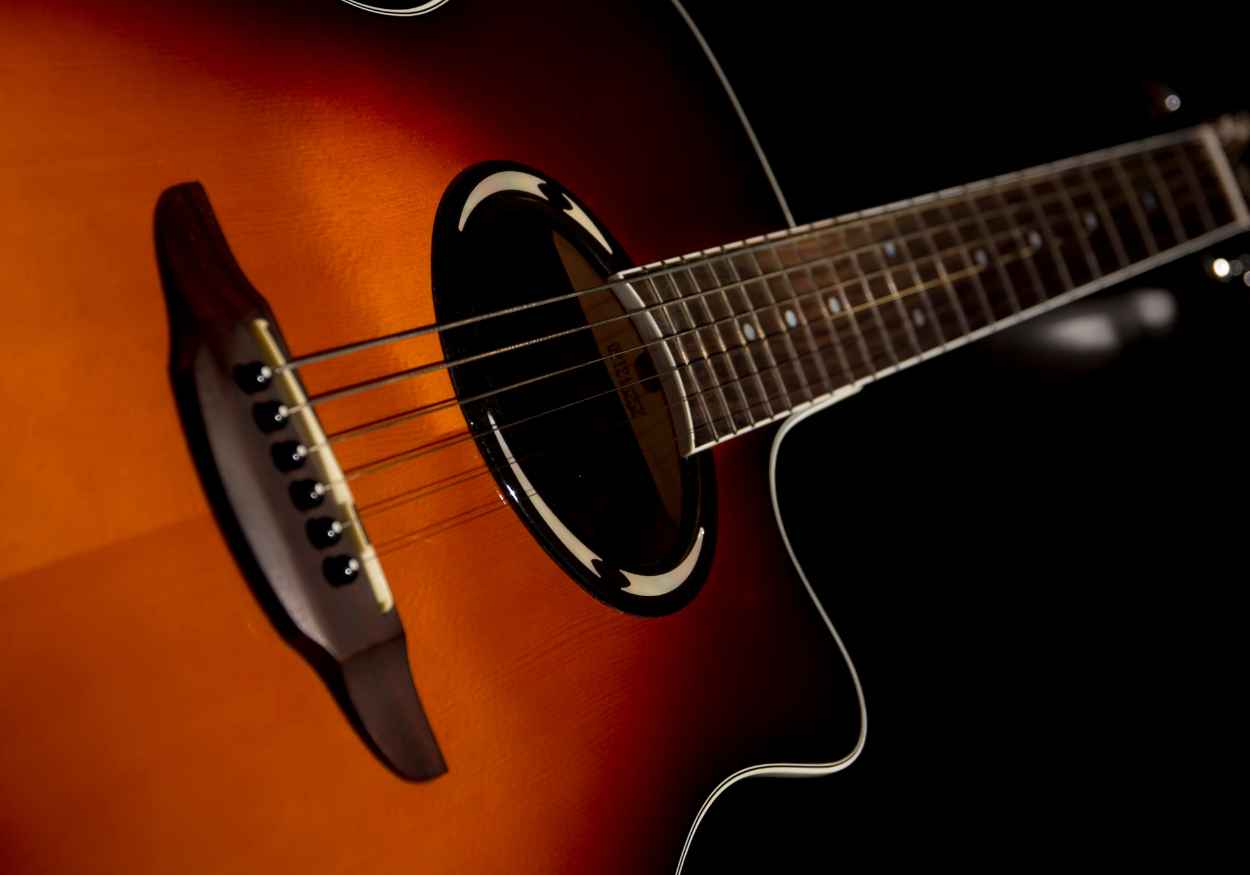Choosing the right tonewood for your guitar can greatly impact its sound, feel, and overall playability. Rosewood is a popular option in the construction of guitars, but is it the right choice for you?
Whether you’re in the market for an acoustic, electric, or bass guitar, it’s worth considering the pros and cons of rosewood as a tonewood to determine if it’s the right fit for your musical needs.
Rosewood is a good guitar tonewood, particularly for acoustics, as it provides a full-bodied, warm tone with remarkable resonance, sustain, and volume. Rosewood’s rich, warm tone can greatly enhance the overall tone of the guitar.
With years of experience playing guitars crafted from diverse tonewoods, I am equipped to provide a comprehensive evaluation of their attributes. In this article, we will delve into the properties of Rosewood, a popular tonewood in guitar making.
I will outline its tonal characteristics, feel, sustain, pricing, and other important factors to give you a well-rounded understanding of its capabilities as a tonewood.
Whether you’re a seasoned player or just starting out, this article will help you determine if Rosewood is the right choice for your musical journey.
Note: If you are currently looking to buy guitar but don’t know which material yet, you can check out my other articles about those other marterials:
- Ash: The Ultimate Tonewood? Pros, Cons, Weight & Tone Analysis
- Maple Magic: The Pros & Cons of This Tonewood for Your Guitar
- 6 Best Tonewood For Electric Guitars Compared!
Rosewood: Explained
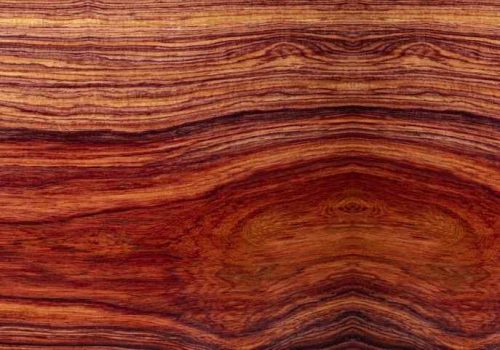
Rosewood
Rosewood is a highly sought-after material in guitar making, particularly for acoustic guitars where it is used for the back and sides. With a hard and dense structure, it offers a rich, full sound that is highly desirable in musical instruments.
Rosewood is a favored tonewood for guitar players due to its complex, warm tone and beautiful natural appearance. The wood’s ease of bending, stability, and durability make it a popular choice for acoustic guitar backs and sides, as well as fretboards. East Indian Rosewood is often preferred for its smooth and gentle tone, excellent bendability, strength, and affordability compared to Brazilian Rosewood.
While its density and hardness make Rosewood a sturdy material for musical instruments, it can be difficult to photograph accurately. Some guitar manufacturers have turned to alternative woods due to restrictions from CITES, but others like Taylor still offer Rosewood models to customers outside the US.
For those who prefer a warm tone, the natural feel of the wood, and a reduction of brightness that can be caused by the soundboard or new strings, Rosewood is an excellent choice. High-end furniture and musical instruments are often made with Rosewood, adding to its luxurious appearance.
Rosewood: The Pros & Cons Summarized
Pros of Rosewood
- Complex, Warm Tone: Rosewood is known for its rich, warm tone that adds depth and complexity to the guitar’s sound.
- Natural Beauty: The natural beauty of rosewood adds to the visual appeal of the instrument.
- Sturdy: Its high density and hardness make rosewood a strong and durable material for building guitars.
- Long sustain: Rosewood is known for its good sustain, meaning notes and chords played on the guitar will ring out longer.
- High bendability: Rosewood is relatively easy to bend, making it an ideal material for curved or contoured guitar bodies.
- Stable: Rosewood is stable and does not warp or crack easily, making it a reliable option for guitar building.
- Affordable: East Indian Rosewood, in particular, is known for being more affordable than other types of rosewood, such as Brazilian Rosewood.
- Versatile: Rosewood is used for building a variety of guitars, including acoustics, electrics, and basses, making it a versatile material for guitar building.
Cons of Rosewood
-
- Heavy: Rosewood is a dense and heavy material, which can add weight to the guitar, making it less comfortable to play for extended periods of time.
- Less available: Rosewood is regulated by the Convention on International Trade in Endangered Species (CITES), which can limit its availability and increase its cost.
- Expensive: Rosewood can get more expensive because the wood is less available.
- Maintenance required: Rosewood is prone to scratches and dents, which can detract from its natural beauty over time. Regular maintenance and care are necessary to keep the wood looking its best.
Is Rosewood A Good Tonewood For Guitar Body?
| Rosewood Characteristic | Review |
| Tone | The soft, rich and warm tone |
| Sustain | Great (Especially for acoustics) |
| Weight | Heavy |
| Feel | Natural and smooth Feel |
| Cost | Expensive (Due to its rarity) |
| Popularity | Quite popular |
Tone: Rosewood Guitar
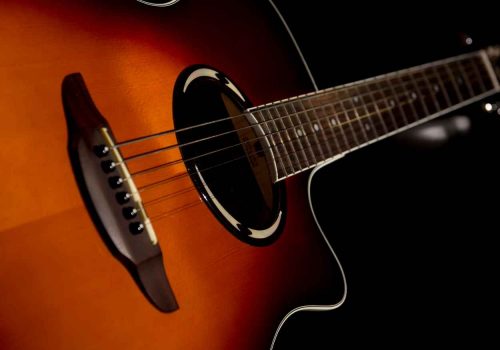
The tone produced by Rosewood on a guitar is warm and has a balanced tonal spectrum with clear high frequencies, a rich and pronounced mid-range, and a deep, resonant bass. This makes it a popular choice for acoustic, bass, and classical guitars.
Rosewood provides a warm and harmonious tone, making it ideal for the back, sides, and bridge of an acoustic guitar. Its porous nature enhances the tone quality by increasing the guitar’s volume and resonance.
When compared to other tonewoods such as mahogany, Rosewood offers a brighter and more vibrant sound, while mahogany provides a warmer and fuller tone with more emphasis on the mid-range.
It’s important to note that the type of Rosewood used, whether it’s Brazilian or East Indian, does not greatly affect the tone produced. Both types are known for producing warm and smooth tones, and can help tame the brightness of new guitar strings on an acoustic guitar.
Sustain: Rosewood Guitar
Rosewood is known for providing a long sustain to the guitar. The dense and hard nature of the wood allows it to transfer vibrations effectively, leading to a longer sustain. A longer sustain can help the notes ring out longer, adding to the overall tonality of the instrument.
Additionally, the porous nature of Rosewood helps absorb and distribute the vibration energy evenly, adding to its sustain capabilities. This makes Rosewood a popular choice for guitar bridges and fretboards, as these areas play a significant role in determining the guitar’s sustain.
However, it is essential to note that the sustain of a guitar depends on many factors, including the wood’s density, the guitar’s construction, and the strings used. So, you need to make sure those other factors are taken care of as well!
Weight: Rosewood Guitar

Weight is important if you play guitar standing
Rosewood guitars are generally heavier because the wood itself is heavy, the instrument no doubt will also be heavy.
While the weight of a Rosewood guitar can make it feel heavy and less comfortable to play, it’s also the main reason why rosewood guitars have great overall stability and sustain. Guitar players who prefer a lighter weight instrument may prefer to choose a different type of wood for their guitar’s construction.
If you are the type of guitarists that often play live while standing, then I suggest looking into other lighter guitars like maple.
Hardness: Rosewood Guitar
Rosewood guitars are hard and durable guitars – allowing it to withstand the stresses of frequent use and resist damage from wear and tear.
However, rosewood’s hardness can also make it difficult to work with during the manufacturing process (which contributes to its higher cost). For example, bending and shaping the wood into the desired shape for guitar components can be challenging and may require specialized tools and techniques.
In general, the hardness of rosewood makes it a great choice for guitar components such as the back, sides, and bridge. These parts of the guitar are subjected to a lot of stress and need to be able to withstand the forces of playing and tuning. The hardness of rosewood ensures that the guitar will remain in good condition for years to come and will not easily crack or deform.
Feel: Rosewood Guitar Body
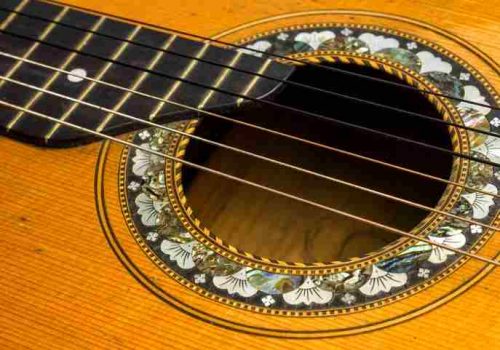
The feel of a rosewood guitar is smooth and warm to the touch. Because of its density and oil content, the wood has a natural grip, which is comfortable and doesn’t slip when playing.
The hand feels comfortable and supported, which can be especially important for those who play for extended periods of time.
Additionally, the natural beauty of the rosewood grain can add to the overall aesthetic appeal of the guitar, making it visually appealing as well as comfortable to play. This can also add to the perceived value of the instrument.
Cost: Rosewood Guitar Body
Rosewood guitars are generally more expensive than others because it’s not as available and because it’s also a durable wood that will last a long time.
That said, the cost of a rosewood guitar varies greatly and is influenced by several factors. One of the main factors is the type of rosewood used, with some species being more expensive than others. For example, Brazilian rosewood is generally considered to be the most desirable, and therefore the most expensive, type of rosewood used in guitar making.
Another factor that affects the cost of a rosewood guitar is the guitar manufacturer. High-end guitar brands tend to use premium materials and craftsmanship, which results in higher prices. On the other hand, lower-priced guitars may use lesser-quality rosewood or may have lower production costs.
Additionally, the age and rarity of the rosewood can also affect the cost. Old-growth Brazilian rosewood, for example, is becoming increasingly scarce, and therefore more expensive. Newer, plantation-grown Brazilian rosewood is less expensive and more readily available, but some guitar players argue that it does not have the same sound or feel as old-growth Brazilian rosewood.
Popularity: Rosewood Guitar Body

Rosewood guitars are quite popular but they are not as popular when compared to maple or ash guitars. This is illustrated from the google trends screenshot I took above.
Google trends aside, I can confirm from my own experience that rosewood guitars are not as popular as maple. However, they are still quite popular nonetheless and is a great choice if you want a durable guitar.
Also Read: Guitar Body Showdown: Maple or Rosewood? (Sound, Weight, Cost)
Verdict: Should You Get a Guitar With Rosewood Body?
Ultimately, whether you should get a Rosewood guitar depends on your personal preferences and needs. If you prefer a warm tone, enjoy the natural feel of wood, and are looking to tame the brightness of a guitar, Rosewood may be a great option.
On the other hand, if you are looking for a lighter guitar or if cost is a concern, you may want to consider other tonewoods. It is best to try out different guitars and experiment with different materials to determine what works best for you.
Rosewood is a popular tonewood choice for acoustic, bass and classical guitars. It provides the guitar with a warm and articulate tone, with excellent low-end and high-end clarity, and a rich yet subtle midrange. Rosewood guitars generally have a smooth harmonic sound and are often used for the back, sides, and bridge of acoustic guitars, as well as on some classical guitars.
Rosewood is a dense and hard material, which contributes to its stability and durability. However, it is also relatively heavy compared to other tonewoods, which may not be ideal for everyone. In terms of feel, Rosewood can be smooth and comfortable to play, and its porous nature can enhance tone quality.
As for the cost, Rosewood can be more expensive than other tonewoods due to its popularity and relative scarcity. It is important to note that restrictions imposed by CITES on the trade of certain species of Rosewood have led some guitar manufacturers to switch to alternative materials.
Best Guitar With Rosewood Body
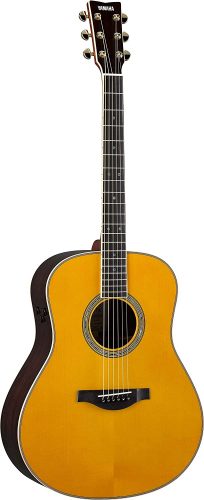
I recommend this Yamaha TransAcoustic rosewood guitar, which has a solid wood construction, a Rosewood body and an Engelmann Spruce top, offers full and articulate sound, awesome unplugged effects, and typically comes with a Urethane finish with an A.R.E.
The aging process, hence producing a vintage tone, is something I would highly recommend. This guitar is without a doubt of the highest calibre.
With measurements of 47 x 23.5 x 8, this item weighs 14.52 pounds. It has a Rosewood back, body, fretboard, top, and neck, and comes with two AA batteries. It has 6 numbers of strings, a fixed guitar bridge system, and a Vintage Tint colour.
Some of its features and details are;
- Without the use of additional amplification or effects, the guitar’s built-in reverb and chorus produce amazing results.
- 5-ply neck with a traditional, high-comfort neck profile.
- Solid Engelmann Spruce Top Treated with A.R.E
- Original Jumbo Body with Solid Rosewood Back and Sides.
- SRT Passive Pickup with Zero Impact.
To give a more detailed description of its features, let’s talk about three parts. An actuator, basic controls, and a battery box.
First, the actuator In reaction to the vibrations of the strings is mounted on the inside surface of the guitar back vibrates. The guitar body and the air inside and around it are then subjected to the actuator’s vibrations, which cause the body to produce real reverb and chorus sounds.
For the controls, you may change the line-out volume level and the number of effects with three straightforward knobs. The area of the holes in the body material is reduced by keeping the controls small, which lessens acoustic sound loss.
Talking about the battery box, there are fewer holes needed in the body since the battery box is integrated into the end-pin jack, which minimizes acoustic sound loss. To use as an acoustic-electric guitar, attach the cable from the jack to a PA system or amplifier.
In general, the TransAcoustic Guitar from Yamaha reproduces the amazing experience of playing in a full, live room without the need for any additional amplification or effects—just the guitar itself.
The TransAcoustic Guitar will improve your playing by allowing you to play for longer and more creatively, whether you are practicing, creating, recording, or just having fun.
So far, it ranks 4.5 out of 5 stars as regards customer reviews.


